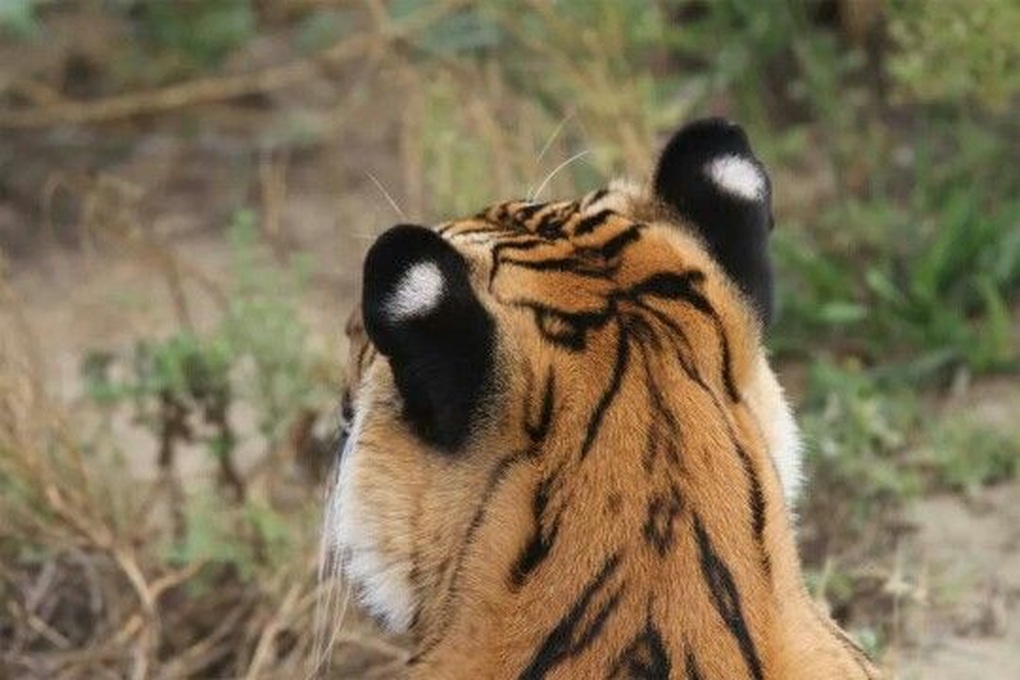Survival shield from behind
In the natural world, many animals possess contrasting round spots that look like eyes on their bodies. Scientists call these "false eyes" or Ocelli.
From delicate butterfly wings to fish and even mammals like tigers, Ocelli play a vital role in survival strategies. Primarily to deceive, intimidate or deflect attacks from predators. It is a highly effective form of surprise or distraction camouflage.

Close-up of the white spot behind a tiger's ear, which scientists call a "false eye" (Photo: Getty).
In tigers, the pair of white spots behind the ears are a classic example of Ocelli. When the tiger lowers its head to rest, stalk prey, or even in moments of relaxation with its ears folded, these two white spots are clearly visible.
From behind, they create a powerful visual illusion, tricking potential predators (such as another tiger, or opportunistic predators) into thinking they are being directly observed by a pair of large, alert eyes.
This element of surprise and feeling of being watched may be enough to cause an would-be attacker from behind to back off, walk away, or at least hesitate, giving the tiger an opportunity to react.
In fact, this “fake eye” tactic is so effective that even humans have adopted it. People living near dense forests such as the Sundarbans (India), where tigers live, have learned to wear masks with eyes on the back of their heads when entering the forest.
This is not an anecdote but a survival tip based on an understanding of the behavior of predators, which tend to avoid direct confrontation when they think they have been detected.

Residents living in the Sundarbans (India) are afraid of being attacked by Bengal tigers so they wear masks behind their necks as a protective device, believing it will help ward off fierce tigers every time they enter the forest (Photo: Getty).
Communication methods
The function of these white spots is not limited to defense. They are also an important tool in intra-species communication of tigers, especially in social interactions and mother-child relationships.
One of the most prominent roles is to help cubs track their mothers. In the dense forest environment with its dense vegetation and limited visibility, maintaining visual contact is paramount.
The high-contrast white spots on the darker fur of the ear flaps act as small “lighthouses”, helping the cubs to easily locate and follow their mother, especially in low-light conditions such as dawn, dusk or when moving quickly through bushes.

The white spot behind the ear will help the tiger cub track its mother (Photo: Getty).
In addition, tiger ears are extremely flexible and play a key role in expressing emotions and intentions. Different positions of ears – upright when curious, pressed back when aggressive or afraid, and turned slightly to listen – are all important visual signals.
The white dots enhance the clarity of these movements and positions.
When a tiger displays aggression by pushing its ears back, the white spots become visible, further emphasizing the visual signal, making the message stronger and more recognizable to other tigers, even from a distance.
This helps to avoid unnecessary conflicts or establish dominance effectively.
Crystallized from millions of years of evolution
The existence of the white spot behind the tiger's ear is not a random arrangement but the result of natural selection that has lasted for millions of years.
Tigers with clear “false eyes” are more effective in defending against predators and communicating with their own kind, and have a higher chance of surviving and reproducing. As a result, the gene for this trait is passed on and becomes more common in the population.
Interestingly, this pair of white spots works perfectly in tandem with the tiger's overall camouflage coat.
While the bright orange fur with black stripes that seems very prominent to the human eye possesses three color channels (trichromacy), it is a perfect cloak of invisibility to their main prey such as deer, elk, and wild boar.

Human eyes can process red, green and blue, so a tiger looks orange to us (right). But deer, elk and wild boar eyes can only process green and blue, making them colorblind (left) (Photo: Getty).
These species typically have only two color perception channels (dichromacy), causing the tiger's orange color to almost blend into the green of the leaves and darkness of the forest, turning them into real "ghosts."
Thus, tigers have the ability to remain completely hidden when hunting, and also have special signals that are activated when needed to defend or communicate.
Source: https://dantri.com.vn/khoa-hoc/tac-dung-dac-biet-cua-cham-trang-tren-tai-ho-con-nguoi-cung-phai-bat-chuoc-20250603225326228.htm


![[Photo] Lam Dong: Images of damage after a suspected lake burst in Tuy Phong](https://vphoto.vietnam.vn/thumb/1200x675/vietnam/resource/IMAGE/2025/11/02/1762078736805_8e7f5424f473782d2162-5118-jpg.webp)
![[Photo] President Luong Cuong receives US Secretary of War Pete Hegseth](https://vphoto.vietnam.vn/thumb/1200x675/vietnam/resource/IMAGE/2025/11/02/1762089839868_ndo_br_1-jpg.webp)


































































































Comment (0)